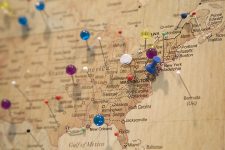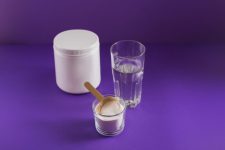24 Easy Ways to Be More Eco-Friendly in 2024
9 min read
Learn easy ways to be more eco-friendly this year in your daily habits, the products you use in your home and on your body, and the food you buy and eat.
Given the concerns of climate change and all the health worries of the past few years, we’ve had enough grim news to last a lifetime. Instead of climbing into a pit of worry and despair, I’ve found that it feels much better to TAKE ACTION!
The small eco-friendly actions we take in our homes and daily lives can most certainly have a positive impact on the planet as a whole, and on our personal health as well.
Note: There may be affiliate links in this post including Amazon Affiliates. Full disclosure.
Why Make the Effort to Be More Eco-Friendly?
It’s easy to think that your small actions don’t matter in the grand scheme of things, but they do!
On top of that, using natural, non-toxic products is better for your health in the long run. All those chemicals that harm the planet, can cause significant harm to your health too.
24 Easy Ways to Be More Eco-Friendly
To help you take positive action, I’ve pulled together a list of 24 ways you can be more eco-friendly this year. The extra good news is that many of these changes will also benefit your health!
1. Switch to reusable towels
Instead of using wasteful, single-use paper towels to clean up messes around the house, keep a stack of reusable un-paper towels under the sink. If you don’t want to spend any money, cut up old t-shirts or bath towels into squares and use them as rags.
2. Ditch the dryer sheets
Most dryer sheets are not only infused with nasty chemicals and strong fragrances, but they are super wasteful too. Now’s the time to finally ditch those toxic dryer sheets and switch to a sustainable dryer sheet alternative like wool dryer balls.
You can get a set of 3 wool dryer balls for only $3 when you sign up for a MightyFix subscription that delivers one super useful, reusable product per month.
3. Buy organic produce
The thought of going 100% organic sounds overwhelming and very expensive. But it’s a smart idea to buy the organic version of the most highly contaminated types of produce. The EWG’s Dirty Dozen is a great place to start.
For affordable organic produce and other foods, try Imperfect Foods. They sell imperfect (mislabeled, overstocks, rescued ingredients) and “ugly” produce at a lower cost than retail. Use my link and get $80 in free groceries ($20 off each of your first four orders).
4. Store food in glass instead of plastic
Plastic is ubiquitous in the kitchen because it’s cheap and easy to buy – but it’s not great for the planet. Plastic can also leach harmful chemicals into food when we heat it in the microwave (don’t do this!!)
Your best move is to slowly transition your food storage to glass instead of plastic. A set of glass food storage containers with lids is not expensive but you can also reuse glass jars from other food products to save money.
5. Skip the plastic wrap
Another way to reduce plastic in the kitchen is to replace plastic wrap and plastic bags with sustainable alternatives. Once you start using reusable bowl covers, silicone bags and beeswax wrap, you’ll never want to go back to flimsy plastic wrap and single-use plastic bags.
6. Use eco-friendly laundry detergent
Conventional laundry detergent is made with powerful chemicals, strong fragrances and artificial colors (that bright blue isn’t very natural, is it?) that are linked to harmful effects on both humans and marine life.
Fortunately, a few companies have perfected the art of making effective laundry detergent from plant-based ingredients that are safe for people and the planet. Find a list of recommended eco-friendly laundry detergent brands and check out my personal favorite brand here. (Take 15% off your first order with code DROPPS15 at checkout.)
7. Eat less meat
Not to sound like a broken record, but meat accounts for 60% of all the greenhouse gasses from food production. Even though we’ve heard this time and time again, it can be hard to make the switch to eating less meat. For Christmas this year I gifted myself the cookbook The Weekday Vegetarians and I’m excited to bring more meatless meals into our family’s dinner rotation.
8. Use eco-friendly cleaning products
Most cleaning products on the market are the opposite of eco-friendly. They pollute the air with harmful VOCs and when they wash down the drain they can have adverse effects on water quality or threaten aquatic life. In short, most cleaning products are not good for human health or the environment.
Eco-conscious companies have figured out how to make effective cleaning products from safe, plant-based ingredients. Find a whole list of my recommended eco-friendly cleaning brands and check out my favorite cleaning concentrate that can be used for a bunch of different cleaning products for the home. (Take 15% off starter kits only with code MINDFULMOMMA at checkout.)
9. Try zero waste personal care products
Used Q-tips, empty toothpaste tubes, spent deodorant containers, pumps from lotion bottles, plastic wrappers…..our daily personal care routines can create a lot of waste. Now would be a great time to start switching to zero waste versions of some of those disposable products that you use every day.
I’ve got a great list of 23 zero waste swaps for your eco-friendly routine up on the blog! For starters, I recommend checking out Last Object – makers of reusable swabs, makeup rounds and tissues.
10. Buy used clothing instead of new
Make this year the one where you finally hit the consignment shops before the mall! It is estimated that the average American throws away about 81 pounds of clothes every year. We can do our part to reduce that number by purchasing used clothing instead of new.
Visit thriftshopper.com for a national directory of thrift stores. (And if you must buy new, opt for high-quality, sustainable clothing brands instead of fast fashion.)
11. Switch to eco-friendly shampoo
Most shampoos are chemical concoctions that may contain ingredients that are harmful to human health and the planet. Some common shampoo ingredients are linked to hormone disruption, scalp burns and even cancer in humans. In addition, chemicals from shampoo can harm aquatic life as well as animals that drink from polluted lakes and streams.
You may think it’s hard to switch something as personal as shampoo, but I’ve got a list of non-toxic shampoo brands for every type of hair, including liquid shampoo, dry shampoo, shampoo bars, natural shampoo for babies and affordable family-sized shampoo.
12. Buy food in bulk
Want to save money and the planet at the same time? Buy as much food as possible from the bulk bins! When you bring your own bags, you avoid wasteful packaging. Plus you can purchase just what you need and avoid wasting food. If you feel at all intimidated about buying from the bulk bins, this post will help you shop the bulk bins like a boss!
13. Use a programmable thermostat
If you don’t already own a programable thermostat, run out and get one STAT! Not only will it help you save energy, but it will save you money because you won’t be heating your house in the middle of the night or when you are on vacation. A programmable thermostat (I use a Nest thermostat) makes it easy to make temperature changes automatically!
14. Buy eco-friendly toilet paper
Name something you need to use multiple times per day that takes a lot of resources to make and then is only used once. Yep, we’re talking about toilet paper. You can’t really avoid using it (unless you’re willing to try cloth No? Me neither!), but there are ways to make toilet paper more eco-friendly.
This year make a commitment to buying either 100% recycled or 100% bamboo toilet paper. If you can’t find it at the store, Who Gives a Crap will deliver it to your doorstep. Easy peasy.
15. Buy refillable products
Think of all the plastic bottles and containers you could avoid if you just started refilling instead of buying new. This is true for cleaning products like dish detergent and hand soap, as well as personal care products like shampoo, body wash and even some skincare and makeup products.
More and more companies are offering refill pouches and packages that allow you to refill the bottles you already have. One of my favorites is Grove Collaborative.
16. Love your leftovers
One of the best eco-friendly (and frugal) tips around is to simply eat the food that you already have! According to the USDA, between 30% to 40% of food is wasted in the United States. Think of all the energy, water and other resources that could be saved if we only produced the amount of food we needed. Zero Waste Chef has some great ideas for cooking without waste.
17. Prioritize reusable bottles
Stop allowing yourself to pick up a coffee or water on-the-go unless you have your reusable bottle or coffee mug with you. This will save countless disposable plastic bottles and single-use cups from going into the landfill. Reusable bottles are affordable and easy to find but if you want to splurge on a nice bottle that you’ll love carrying everywhere, get yourself a Swell bottle.
18. Skip plastic straws
On a similar note, make a commitment to refuse a straw whenever you get drinks away from home. That way you won’t be contributing to the 500 million straws wasted per day in the United States. If you prefer to use a straw, carry one with you in your bag. FinalStraw is a collapsible straw that comes with a handy cleaning brush.
19. Strive for plastic-free grocery shopping
A trip to the grocery store can result in a lot of plastic coming into your home. From produce packaged in plastic clamshells, to pasta sauce in plastic jars, to the plastic bags you carry it all home in….it all adds up to a lot of plastic. Try your hardest to shop plastic-free and even if you’re not perfect, you’ve still helped the planet in your own way. If you need supplies, this Zero Waste Grocery Kit is a great place to start.
20. Rethink transportation
Instead of relying on your car to get you everywhere you need to go, stop to think about whether you could get there another way. Biking or walking is great for your health and will lower your personal carbon footprint. Taking public transportation or carpooling helps lower your impact too.
21. Green your lunch
Whether it’s the plastic wrap, disposable bags or the wrappers from individually packaged foods, your daily lunch routine can create a lot of waste. It’s easy to improve the situation when you have reusable lunch containers and snack bags, reusable utensils and a durable lunch bag. Packing nutritious, whole foods instead of convenience foods makes your lunch healthier too!
22. Use biodegradable products
We all have times when disposable is the only way to go….like the big parties, picnics or meals on-the-go. Do your best to have biodegradable or compostable plates, cups and utensils on hand to pull out for those times, so you don’t end up using plastic.
23. Switch to sustainable makeup
Most makeup is packaged in plastic and it’s often hard to recycle your empties given the complicated combination of materials like mirrors, pumps and applicators. Kudos to the companies that are working to solve this problem by making their makeup packaging more sustainable. My list of 14 sustainable makeup brands is a great place to start making this swap!
24. Compost food scraps
The easiest thing to do with food scraps is to toss them into the garbage can. But when you compost your food scraps, you not only keep waste out of the landfill, you also create nutrient-rich soil to use in your garden for plants.







